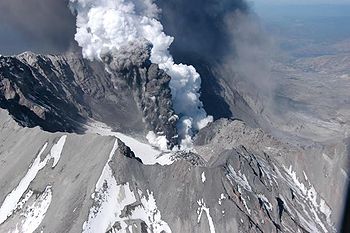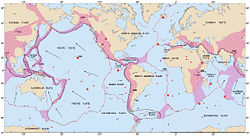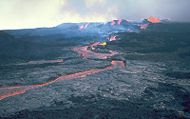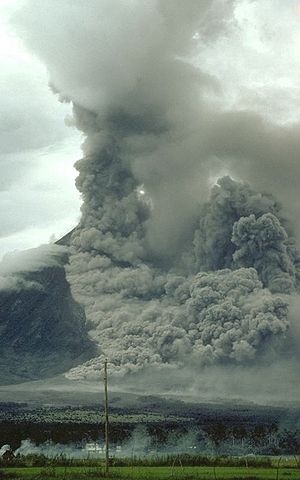

A volcano is a geothermal vent at the Earth's surface through which magma (molten rock) and associated gases escape. Mountains built by such activity are also referred to as volcanoes. Eruptions produces a wide variety of hazards that can kill people and destroy property. Large explosive eruptions can endanger people and property hundreds of miles away and even affect global climate. Some volcanic hazards, such as landslides, can occur even when a volcano is not erupting.[1]
Volcanic eruptions are important for creation science because they can provide vivid examples of how catastrophic processes are able to form features that are typical of the fossil record (i.e. layered rock). Since uniformitarian thought dominates geology today, much of the earth's features have been interpreted as having formed slowly over long periods of time. In some cases volcanoes, like Mount St. Helens, have illustrated that catastrophic processes are able to form thick beds of rock with fine laminae.
he who looks at the earth, and it trembles, who touches the mountains, and they smoke. Psalm 104:32

The world's volcanoes are not randomly distributed over the Earth's surface. They tend to be concentrated in narrow zones along plate boundaries called hot spots. There are over 160 volcanoes that have erupted in the United States in past 10,000 years.[2] (more than 50 in the past 200 years [1]), and with rare exception, all have occurred in either Alaska, Hawaii, or the Pacific Northwest.[2]
The theory of plate tectonics tells us that the Earth's rigid outer shell (lithosphere) is broken into a mosaic of oceanic and continental plates which can slide over the plastic aesthenosphere, which is the uppermost layer of the mantle. The plates are in constant motion. Where they interact, along their margins, important geological processes take place, such as the formation of mountain belts, earthquakes, and volcanoes.[3]
The lithosphere covers the whole Earth. Therefore, ocean plates are also involved, more particularly in the process of sea-floor spreading. This involves the midocean ridges which are a system of narrow submarine cracks that can be traced down the center of the major oceans. The ocean floor is being continuously pulled apart along these midocean ridges. Hot volcanic material rises from the Earth's mantle to fill the gap and continuously forms new oceanic crust. The midocean ridges themselves are broken by offsets know as transform faults.[3]
Volcanic eruptions are one of Earth's most dramatic and violent agents of change. Not only can powerful explosive eruptions drastically alter land and water for tens of kilometers around a volcano, but tiny liquid droplets of sulfuric acid erupted into the stratosphere can change our planet's climate temporarily.[4] Most volcano hazards are associated with eruptions. However, some hazards, such as lahars and debris avalanches, can occur even when a volcano is not erupting.[5]
Eruptions often force people living near volcanoes to abandon their land and homes, sometimes forever. Those living farther away are likely to avoid complete destruction, but their cities and towns, crops, industrial plants, transportation systems, and electrical grids can still be damaged by tephra, ash, lahars, and flooding. Fortunately, volcanoes exhibit precursory unrest that if detected and analyzed in time allows eruptions to be anticipated and communities at risk to be forewarned with reliable information in sufficient time to implement response plans and mitigation measures.[4]

Lava flows are streams of molten rock that pour or ooze from an erupting vent. Lava is erupted during either nonexplosive activity or explosive lava fountains. Lava flows destroy everything in their path, but most move slowly enough that people can move out of the way. The speed at which lava moves across the ground depends on several factors, including (1) type of lava erupted and its viscosity; (2) steepness of the ground over which it travels; (3) whether the lava flows as a broad sheet, through a confined channel, or down a lava tube; and (4) rate of lava production at the vent.[6]
Fluid basalt flows can extend tens of kilometers from an erupting vent. The leading edges of basalt flows can travel as fast as 10 km/hour on steep slopes but they typically advance less than 1 km/hour on gentle slopes. But when basalt lava flows are confined within a channel or lava tube on a steep slope, the main body of the flow can reach velocities >30 km/hour. Viscous andesite flows move only a few kilometers per hour and rarely extend more than 8 km from their vents. Viscous dacite and rhyolite flows often form steep-sided mounds called lava domes over an erupting vent. Lava domes often grow by the extrusion of many individual flows >30 m thick over a period of several months or years. Such flows will overlap one another and typically move less than a few meters per hour. [6]
Volcanoes emit gases during eruptions. Even when a volcano is not erupting, cracks in the ground allow gases to reach the surface through small openings called fumaroles.
More than ninety percent of all gas emitted by volcanoes is water vapor (steam), most of which is heated ground water (underground water from rain fall and streams). Other common volcanic gases are carbon dioxide, sulfur dioxide, hydrogen sulfide, hydrogen, and fluorine. Sulfur dioxide gas can react with water droplets in the atmosphere to create acid rain, which causes corrosion and harms vegetation. Carbon dioxide is heavier than air and can be trapped in low areas in concentrations that are deadly to people and animals. Fluorine, which in high concentrations is toxic, can be adsorbed onto volcanic ash particles that later fall to the ground. The fluorine on the particles can poison livestock grazing on ash-coated grass and also contaminate domestic water supplies.[1]
Cataclysmic eruptions, such as the June 15, 1991, eruption of Mount Pinatubo (Philippines), inject huge amounts of sulfur dioxide gas into the stratosphere, where it combines with water to form an aerosol (mist) of sulfuric acid. By reflecting solar radiation, such aerosols can lower the Earth's average surface temperature for extended periods of time by several degrees Fahrenheit (°F). These sulfuric acid aerosols also contribute to the destruction of the ozone layer by altering chlorine and nitrogen compounds in the upper atmosphere.[1]

A pyroclastic flow is a high-density, ground-hugging avalanche with temperatures that may be greater than 500° C. - temperatures sufficient to burn and carbonize combustible material. They consist of hot ash, pumice, rock fragments, and volcanic gas that rushes down the side of a volcano as fast as 100 km/hour or more.[7] With rock fragments ranging in size from ash to boulders, pyroclastic flows knock down, shatter, bury or carry away nearly all objects and structures in their way.[8]
Pyroclastic flows vary considerably in size and speed, but even relatively small flows that move less than 5 km from a volcano can destroy buildings, forests, and farmland. And on the margins of pyroclastic flows, death and serious injury to people and animals may result from burns and inhalation of hot ash and gases. Pyroclastic flows generally follow valleys or other low-lying areas and, depending on the volume of rock debris carried by the flow, they can deposit layers of loose rock fragments to depths ranging from less than one meter to more than 200 m.[8] Once deposited, the ash, pumice, and rock fragments may deform (flatten) and weld together because of the intense heat and the weight of the overlying material.[7]
They may result from the explosive eruption of molten or solid rock fragments, or both. They may also result from the nonexplosive eruption of lava when parts of dome or a thick lava flow collapses down a steep slope. Most pyroclastic flows consist of two parts: a basal flow of coarse fragments that moves along the ground, and a turbulent cloud of ash that rises above the basal flow. Ash may fall from this cloud over a wide area downwind from the pyroclastic flow.[8]
Mudflows or debris flows composed mostly of volcanic materials on the flanks of a volcano are called lahars (an Indonesian term). These flows of mud, rock, and water can rush down valleys and stream channels at speeds of 20 to 40 miles per hour and can travel more than 50 miles. Some lahars contain so much rock debris (60 to 90% by weight) that they look like fast-moving rivers of wet concrete. Close to their source, these flows are powerful enough to rip up and carry trees, houses, and huge boulders miles downstream. Farther downstream they entomb everything in their path in mud.[1]
Historically, lahars have been one of the deadliest volcano hazards. They can occur both during an eruption and when a volcano is quiet. The water that creates lahars can come from melting snow and ice (especially water from a glacier melted by a pyroclastic flow or surge), intense rainfall, or the breakout of a summit crater lake. Large lahars are a potential hazard to many communities downstream from glacier-clad volcanoes.[1]
Occasionally creationists are criticized for believing that many volcanoes erupted in a short span of time (a few decades) because that much heat released would raise the atmospheric and oceanic temperature immensely. In answer, Phil Hoff pointed out that if 2,000 volcanoes were involved (though this number of volcanoes is not suggested by creationists) the air temperature increase would not be 1,500 degrees Celsius but more than a thousand times less. This number of volcanoes would raise the sea temperature less than 2.7 degrees C. The heat released by Mt. St. Helens was estimated at about 1.7 x 1018 joules (during nine hours) which is four million times less than that needed for 2,000 volcanoes to raise the atmosphere's temperature 1,500 degrees.[9]
Creationist
Secular
|
||||||||||||||||||||